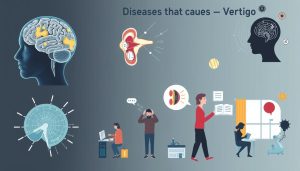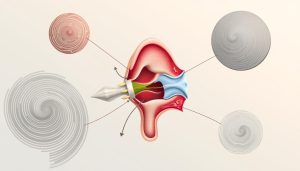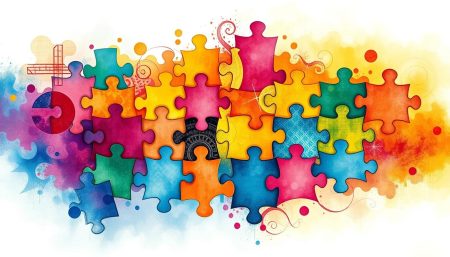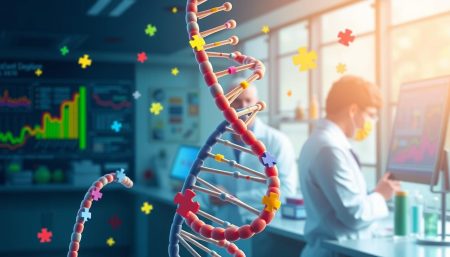Autism Spectrum Disorder (ASD) is a group of conditions that affect how people interact, communicate, and behave. It’s important for doctors, teachers, and families to understand autism. This helps them provide better support and care.
This article is a detailed guide to the different ASD types. It explains why it’s key to recognize each type within the autism spectrum disorders categories.
Looking into the CDC’s research on ASD and the DSM-5’s new criteria helps us understand autism better. Autism Speaks also offers valuable resources. By learning about autism, we can offer more tailored and inclusive care.
Understanding Autism Spectrum Disorder
Autism Spectrum Disorder (ASD) is a wide range of conditions. They include challenges with social skills, repetitive behaviors, speech, and nonverbal communication. The term autism spectrum shows how different each person’s experience can be. This is because the autism spectrum classification has many types of autism spectrum conditions, each with its own traits and challenges.
ASD was first seen as a unique condition a long time ago. Thanks to medical science, we now know more about it. At first, it was part of a bigger group called childhood schizophrenia. But now, we have many types of ASD, each with its own needs for treatment.
| Year | Classification | Description |
|---|---|---|
| 1943 | Early Autism | Leo Kanner first called it out in 1943. He said it was about feeling alone and needing things to be the same. |
| 1980 | Infantile Autism | The DSM-III in 1980 made it clearer for kids. It gave specific rules for diagnosing it in young children. |
| 1994 | ASD in DSM-IV | The DSM-IV in 1994 added more types. It showed different levels of severity, like Asperger syndrome. |
| 2013 | ASD in DSM-5 | The DSM-5 in 2013 made it simpler. It put all types under one category to show it’s a spectrum. |
Today, knowing the autism spectrum classification helps a lot. It lets us give the right help to each person. It’s key for doctors and everyone else to make a better world for those with ASD.
Different Types of Autism Spectrum Disorder
Autism has different types, each with its own challenges. Knowing these differences helps in making accurate diagnoses and creating better plans for help. Let’s look at the main autism subtypes.
Classic Autism or Autistic Disorder
Classic Autism is also just called autism. It’s known for big delays in language, trouble with social and communication skills, and odd behaviors. People with this type often struggle to have two-way conversations, a key sign of autism.
This type is often linked with stronger sensory sensitivities and brain challenges.
Asperger’s Syndrome
Asperger’s Syndrome is less severe than classic autism but shares similar social interaction challenges. People with Asperger’s usually don’t have language or thinking delays. They often focus deeply on certain topics, making them stand out.
Pervasive Developmental Disorder – Not Specified (PDD-NOS)
PDD-NOS is a less clear-cut autism type, with milder symptoms. It’s for those who show some autistic traits but don’t fit into other autism categories. It’s sometimes called “atypical autism” because its symptoms don’t match classic autism.
Symptoms can range from mild social awkwardness to serious communication problems.
Thanks to the DSM-5, doctors now see autism as a wide spectrum. This view shows how complex autism is and how each diagnosis is unique.
ASD Classifications Over Time
Looking back at autism spectrum disorders categories and ASD diagnoses shows how our understanding has grown. In the past, autism was split into different types, each with its own traits and rules for diagnosis. Over time, these types have merged into a single spectrum, thanks to updates in the DSM (Diagnostic and Statistical Manual of Mental Disorders).
The move to a spectrum view was needed for a more accurate and inclusive system. At first, there were labels like Asperger’s Syndrome, PDD-NOS, and classic autism. Each had its own set of expectations for growth, treatment, and results. But with DSM-5, these were all combined into one diagnosis: Autism Spectrum Disorder. This change shows that the lines between old types are blurry and often mix, making a single spectrum a better fit for the diverse autism community.
This change has big effects. It lets more symptoms be recognized, making diagnosis more precise and helping more people get the right help. It also changes how people see autism, leading to more understanding and acceptance of the autism community’s diversity.
| Former Classification | Current Status Under DSM-5 | Impact on Treatment Access |
|---|---|---|
| Asperger’s Syndrome | Integrated into ASD | Expanded access to services tailored for milder symptoms |
| PDD-NOS | Integrated into ASD | Broader recognition of atypical forms enhances early intervention |
| Autistic Disorder | Integrated into ASD | Unified approach improves consistency in treatment across severities |
Knowing how ASD classifications have changed shows the scientific progress and the need for ongoing updates. As we learn more about autism, the rules and types will likely change again. This will affect everything related to diagnosing and treating ASD.
Key Symptoms of Autism Spectrum Disorders
Autism Spectrum Disorders (ASD) are a group of conditions that affect how people develop. Each type shows in different ways, impacting people in unique ways. Knowing the main symptoms helps us understand the types of autism spectrum disorders and how to help.
Communication Challenges
Many people with ASD have trouble talking. Some might not speak at all, while others struggle with the way they say things. This can make it hard to connect with others and can lead to misunderstandings.
Social Interaction Difficulties
People with ASD often find it hard to interact socially. They might have trouble making eye contact, understanding social signals, or sharing feelings. These issues make it tough to build and keep friendships. The way these problems show up can vary a lot, showing how different ASD can be.
Repetitive Behaviors and Restricted Interests
Repeating actions and liking things in a certain order are common in ASD. This could be things like stacking toys or being very interested in certain topics. These signs help us see the patterns in different ASD types.
Spotting these signs early in kids can help a lot. It can lead to better support and a better life for those with ASD. Knowing about ASD types also helps teachers and doctors give more tailored help to those with autism.
Autism Spectrum Disorders Categories
The autism spectrum classification system has changed a lot. It now focuses on a spectrum with different levels of severity, not strict categories. This change comes from the DSM-5 criteria, which shows a deeper understanding of autism spectrum variations.
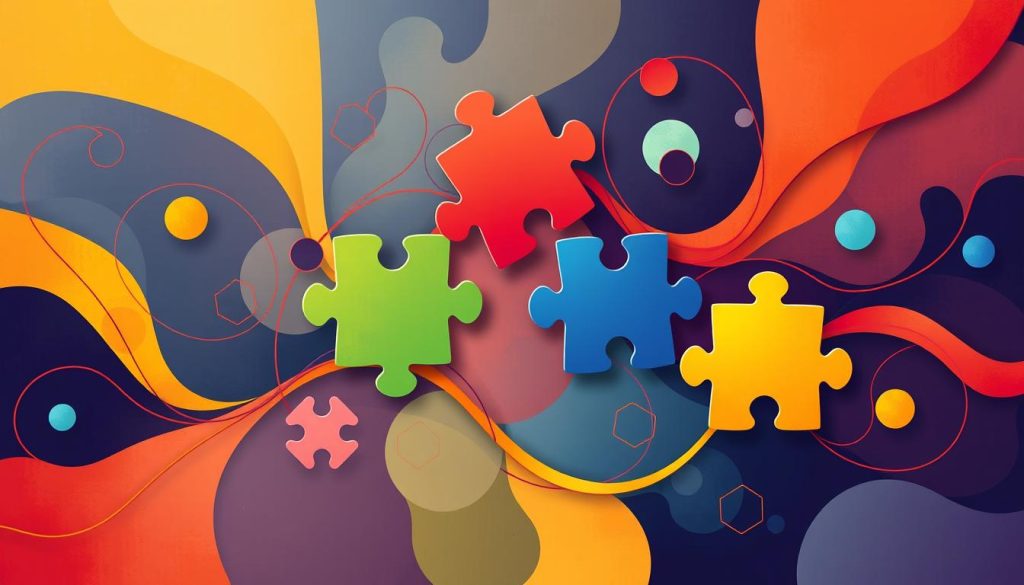
This new way of classifying autism is very important. It helps doctors create better plans for each person. They can now focus on what each person needs, based on their own strengths and challenges.
The DSM-5 has changed how we see autism. It no longer separates Asperger’s Syndrome and PDD-NOS. Instead, it puts them all under the umbrella of ASD. This way, everyone gets the support they need, no matter how they show autism.
- Comprehensive evaluation criteria focusing on two core areas: social communication and repetitive patterns of behavior.
- Specifiers and severity levels are used to describe the presentation of symptoms effectively.
- Consideration of co-occurring conditions which may influence the character and management of ASD.
There are ongoing debates in the medical field about how to classify autism. Some think we need more subtypes for better care. Others fear it might make things more complicated. It’s important to keep thinking about how we classify and support autism to help everyone.
High-Functioning Autism Explained
The term high-functioning autism is part of the autism spectrum disorders categories. It describes people who do well in some areas but struggle in others. It’s key to know what this term really means and the range of experiences it covers.
What High-Functioning Autism Means
High-functioning autism isn’t a formal diagnosis. It’s a term for those who do better in some areas, like thinking and talking. Yet, they might find social interactions and handling sensory inputs hard, affecting their daily life.
Challenges and Strengths
People with high-functioning autism often have special talents. They can focus deeply, remember details well, and excel in certain interests. But, they also face big hurdles like socializing, managing feelings, and dealing with a world made for others.
| Challenges | Strengths |
|---|---|
| Social interaction difficulties | Exceptional memory skills |
| Emotional regulation issues | Deep focus in areas of interest |
| Sensory sensitivity | High cognitive capabilities |
Exploring high-functioning autism within autism spectrum disorders categories deepens our understanding. It also highlights the need for support and help tailored to their unique needs.
Asperger’s Syndrome: A Closer Look
Asperger’s Syndrome is a special part of autism spectrum conditions. It has its own way of showing in behavior and how people interact. This part will look at what makes Asperger’s unique and how to deal with it, knowing its place in autism history.
Distinguishing Features of Asperger’s Syndrome
Even though the DSM-5 doesn’t list Asperger’s as a separate condition, it’s very clear in clinics and society. People with Asperger’s are smart but find social and sensory stuff hard. They usually talk well but might miss out on things like irony or jokes.
Coping Strategies and Interventions
Dealing with Asperger’s means using what the person is good at. Treatments include therapy, learning social skills, and school help. The goal is to help them be more independent and function better. Because everyone with Asperger’s is different, treatments need to be made just for them.
| Intervention | Goals | Expected Outcome |
|---|---|---|
| Behavioral Therapy | Improve coping with emotions and reduce disruptive behaviors | Enhanced emotional control and societal contribution |
| Social Skills Training | Boost understanding and application of social norms | Improved interpersonal interactions and relationships |
| Educational Support | Customized learning approaches to cater to individual learning styles | Academic success and better adaptation to schooling environments |
Getting to know Asperger’s Syndrome helps us offer better support. It shows we value their unique abilities and challenges. Moving from a separate diagnosis to part of autism spectrum shows we understand it better. It highlights the need for a detailed approach to autism.
Autism Subtypes and Personalized Care
Exploring autism subtypes shows a wide range of expressions, highlighting the need for personalized autism care. Understanding each person’s unique traits helps healthcare experts create care plans that fit their needs and abilities.
Importance of Individualized Diagnosis
Every ASD type is different, making a single diagnosis method not work. Doctors must look at each subtype, like classic autism and Asperger’s, to truly understand a person’s strengths and challenges. This detailed view is key to creating effective, personalized autism care plans.
Customizing Treatment Plans
Creating treatment plans that meet the specific needs of autism subtypes is essential. The American Academy of Pediatrics supports this approach, saying it greatly improves the lives of those with ASD.
| Autism Subtype | Focus of Personalized Care | Examples of Interventions |
|---|---|---|
| Classic Autism | Communication Skills | Speech Therapy, PECS |
| Asperger’s Syndrome | Social Interaction | Social Skills Groups, Cognitive Behavioral Therapy |
| PDD-NOS | Behavioral Flexibility | Behavioral Intervention Plans, Occupational Therapy |
Autism Spectrum Classification and Severity Levels
The way we understand autism spectrum classification has changed a lot. This change shows we now see autism in more ways than before. It’s about understanding the different ways autism can show up.
Today, we look at how well someone talks, interacts, and behaves. This helps us figure out the best way to help them.
- Assessment of Severity: We divide autism into levels to know how much help someone needs. These levels are based on how well they do daily tasks and how they communicate and interact.
- Ethical Considerations: While levels help us plan, they also raise big questions. How we label someone can change how others see and treat them.
Autism spectrum classification covers a wide range of abilities and challenges. It helps us create plans that make life better for each person.
| Severity Level | Description | Support Needed |
|---|---|---|
| Level 1 | Requires support | Minimal; occasional support to independence |
| Level 2 | Requires substantial support | Marked difficulties in verbal and nonverbal communication |
| Level 3 | Requires very substantial support | Severe impairments in functioning, requiring more intensive support |
The talk about these levels and how they affect us is ongoing. It’s important because it shapes how society sees and includes people with autism.
Rethinking ASD Diagnoses in the Modern Era
Today, we have new ways to understand and diagnose autism spectrum disorder (ASD). Our understanding of ASD has grown, showing how different it can be for each person. This change helps us see the complexity and variety of ASD.
The Evolution of Diagnostic Criteria
How we diagnose autism has changed a lot over time. At first, we only looked at the most obvious signs. Now, we can spot even the smallest signs of different types of autism spectrum disorder. This shift is clear when we compare old and new diagnostic manuals.
| DSM Edition | Year | Key Changes in ASD Criteria |
|---|---|---|
| DSM-III | 1980 | Introduction of Infantile Autism |
| DSM-IV | 1994 | Expansion to include Asperger’s Syndrome |
| DSM-5 | 2013 | Consolidation into Autism Spectrum Disorder |
The Impact of Early Intervention
Starting early interventions has made a big difference in managing ASD. Studies show that early help can change a child’s development for the better. It helps reduce symptoms and improves social and communication skills.
Research shows early action and custom plans are key to better outcomes for kids with autism.
As we learn more about ASD, we can make our diagnosis and treatment plans even better. This is important for making sure each person gets the right help to reach their full development.

Autism Spectrum Variations: Co-occurring Conditions
Understanding autism spectrum variations means knowing about other conditions that often happen with types of autism spectrum disorders. These conditions make diagnosis harder and need special treatment plans.
Conditions like ADHD, anxiety disorders, and sensory processing issues often go with autism. Each one brings its own set of challenges. They can make things harder for people with autism spectrum disorders.
- ADHD (Attention Deficit Hyperactivity Disorder) makes it hard to stay focused or finish tasks.
- Anxiety disorders cause more stress in social situations and new places.
- Sensory processing issues can make someone too sensitive or not sensitive enough to light, sound, and touch. This can make daily life and activities harder.
These challenges show why a detailed diagnosis and custom treatment plans are key. Good management often means using a mix of therapies. These therapies should help with both autism symptoms and the needs of co-occurring conditions.
According to the CDC, many people with autism spectrum variations also have other conditions. This shows we need to care for them in a more complete way.
By using therapies that focus on both autism and its related conditions, doctors can help people live better lives. This helps them fit in better in school, work, and social settings.
Girls and Autism: Understanding the Gender Differences
Looking into gender differences in autism shows a complex picture. Girls often face special challenges. Autism is usually seen more in boys, but research shows girls might show symptoms differently. This can lead to them being missed or misdiagnosed.
Identifying Autism in Girls
Finding autism in girls is tricky because their symptoms are different. They might hide their struggles better than boys. This means autism in girls is often not spotted until they’re older.
It’s important to have better ways to find autism in girls. This way, we can help them sooner.
Gender Specific Support and Interventions
After finding out a girl has autism, we need to tailor support. Girls with autism face unique challenges. They might struggle more with social clues and sensory issues.
| Aspect | Impact on Boys | Impact on Girls |
|---|---|---|
| Social Challenges | More overt difficulties; may struggle with social interaction broadly. | Subtle difficulties; might mask symptoms and mimic peers. |
| Diagnosis Age | Typically diagnosed at a younger age. | Often diagnosed later due to subtler manifestation of symptoms or ability to hide them. |
| Intervention Needs | Focus often on behavioral management and direct social skills training. | Requires interventions that consider social subtleties and internalized issues like anxiety and depression. |
Autism in Adults: Recognizing the Signs
As we learn more about autism, it’s key to recognize types of autism spectrum conditions in adults. Spotting autism in adults can help improve their lives. It leads to better support and a higher quality of life for everyone on the autism spectrum.
Adults with autism face special challenges but also have unique strengths. Getting the right job, making social connections, and getting health care that fits their needs is vital. These things help them use their strengths and overcome their challenges.
- Continual social skill development
- Workplace integration strategies
- Access to mental health resources
Stories of adults with autism show how important it is to understand and adapt to their needs. These stories inspire and show us how to support and accept them in society.
| Challenge | Support Strategy |
|---|---|
| Social Interaction | Social skills workshops and support groups |
| Employment | Job coaching and workplace adjustments |
| Personal Relationships | Counseling and relationship education programs |
| Routine Changes | Behavioral therapy to enhance adaptability |
| Communication Barriers | Communication aids and speech therapy |
It’s vital for doctors and support groups to tackle these issues head-on. This way, adults with autism can live happy and productive lives. As we learn more about autism spectrum disorders categories, our support strategies must grow to meet the community’s diverse needs.
ASD Types and the Importance of Inclusivity
In today’s world, knowing about different types of autism spectrum disorder has helped us better understand and diagnose it. This awareness has also shown us how important it is to be inclusive. Embracing neurodiversity means we value and recognize the unique brain differences in people, including those with autism.
Embracing Neurodiversity
The idea of embracing neurodiversity has changed how we talk about autism and other brain differences. It tells us that people with different brains have special strengths. This idea is making places like schools and workplaces more welcoming for everyone.
Creating a More Inclusive Society
To make society more welcoming for people with autism, we need help from many places. This includes groups that fight for rights, schools, and businesses. We’re working on many projects to help neurodiverse people fit into our communities better.
Here are some key steps we’re taking to make society more inclusive for autism:
- Creating special education programs for neurodiverse students.
- Training workplaces to support their neurodiverse employees.
- Reaching out to the community to teach about autism’s strengths and challenges.
These efforts help us accept and celebrate neurodiversity. They make life better for everyone and help us grow together.
| Initiative | Objective | Impact |
|---|---|---|
| Community Education | Raise awareness about types of autism spectrum disorder | Increased public understanding and support |
| Inclusive Hiring Practices | Promote neurodiversity in the workplace | Higher employment rates for neurodiverse individuals |
| Adaptive Learning Environments | Support diverse learning needs | Improved academic outcomes for students with ASD |
As we learn more about neurodiversity and autism inclusivity, we see how it benefits everyone. Our efforts towards inclusivity show that we’re moving forward as a society. We’re becoming more accepting and understanding of all kinds of diversity.
Further Research and Understanding Autism Spectrum Disorder
Exploring autism spectrum disorders is a never-ending journey. It’s key to better lives for those with ASD. The National Institutes of Health (NIH) leads this effort, funding studies to deepen our understanding. These studies look into genetics, environment, and treatment effects.
New technologies are changing how we research autism. Artificial intelligence and machine learning are leading this change. They help create personalized care and support for ASD. These tools improve diagnosis, treatment, and educational programs.
It’s important to keep researching autism. Knowing more about ASD helps everyone. Research will help find better therapies and support. It’s a journey of discovery, bringing hope and new possibilities for those affected.
FAQ
Q: What is Autism Spectrum Disorder?
A: Autism Spectrum Disorder (ASD) is a developmental disorder. It affects how people interact, communicate, and behave. The term “spectrum” means it covers a wide range of symptoms and severity levels. This makes each person’s experience with ASD unique.
Q: How is Autism Spectrum Disorder diagnosed?
A: ASD is diagnosed through behavioral observations and a review of developmental history. The American Psychiatric Association’s DSM-5 criteria are often used. A team of professionals, like psychologists and pediatricians, assesses the individual’s symptoms and behaviors.
Q: What are the main types of Autism Spectrum Disorders?
A: In the past, there were different subtypes of autism, like Classic Autism and Asperger’s Syndrome. But now, the DSM-5 classifies all under one diagnosis: ASD. This change reflects the unique nature of each individual’s symptoms.
Q: Why did the classification of Autism Spectrum Disorders change?
A: The change in classification aims to better reflect the diversity of symptoms. The spectrum approach recognizes the overlap of symptoms. This shift helps in diagnosis, treatment, and understanding of ASD.
Q: What are the key symptoms of Autism Spectrum Disorders?
A: Key symptoms include challenges with communication and social interaction. People with ASD also often have repetitive behaviors or restricted interests. These symptoms vary from person to person.
Q: How do severity levels influence the treatment for Autism Spectrum Disorders?
A: Severity levels help determine the support and services needed. They guide personalized treatment plans. This ensures interventions target specific challenges faced by each individual.
Q: What is high-functioning autism?
A: High-functioning autism refers to individuals with ASD who have strong verbal skills and no intellectual disability. It’s not an official diagnosis but suggests a person can function independently despite autism challenges.
Q: How has the concept of Asperger’s Syndrome changed in recent years?
A: Asperger’s Syndrome was once seen as a milder form of autism with no language delay. The DSM-5 has merged it with ASD. Yet, some communities continue to use the term to describe a specific autism profile.
Q: Why is personalized care important in treating Autism Spectrum Disorders?
A: Personalized care is key because ASD affects people differently. Tailored treatment plans lead to more effective interventions. This approach improves outcomes for individuals on the autism spectrum.
Q: Can adults be diagnosed with Autism Spectrum Disorder?
A: Yes, adults can be diagnosed with ASD. Symptoms may appear differently in adulthood. Some may not get diagnosed until later due to stigma or milder symptoms.
Q: What does embracing neurodiversity mean for individuals with Autism Spectrum Disorder?
A: Embracing neurodiversity means valuing neurological differences, like autism. It’s about creating a society that includes all neurodiverse individuals. This promotes acceptance and support, not trying to “cure” them.
Q: How do co-occurring conditions affect individuals with Autism Spectrum Disorders?
A: Co-occurring conditions, like ADHD or anxiety, can make diagnosis and treatment harder. Understanding and managing these conditions is vital for complete care. It addresses all aspects of an individual’s well-being.
Q: Are there gender differences in Autism Spectrum Disorders?
A: Yes, there are gender differences in ASD. Girls and women are often underdiagnosed or diagnosed later. This may be due to different symptoms or social expectations. Awareness and tailored interventions are essential.
Q: What is the significance of further research on Autism Spectrum Disorder?
A: Continued research on ASD is vital. It helps us understand causes, develop better interventions, and improve life for those on the spectrum. New technologies and methods offer opportunities to advance our knowledge.




